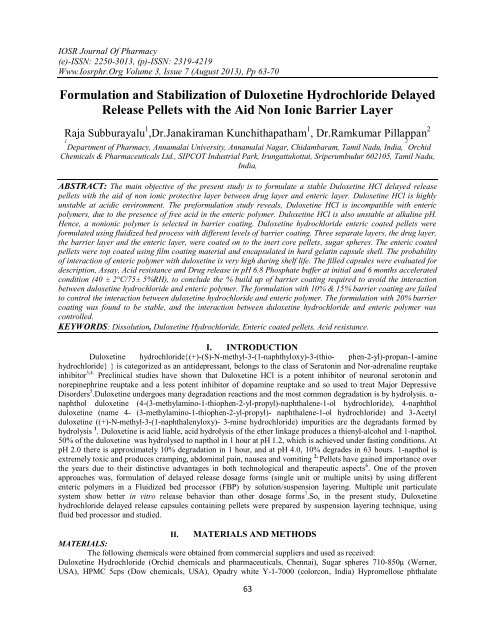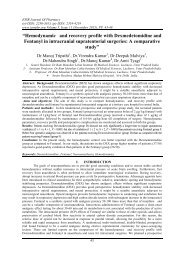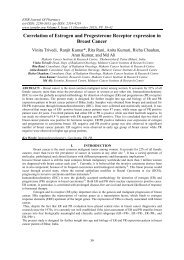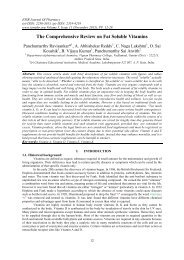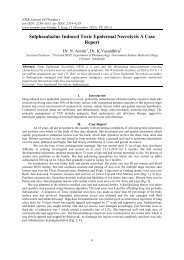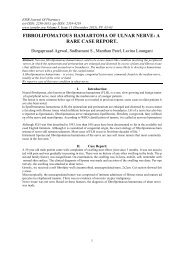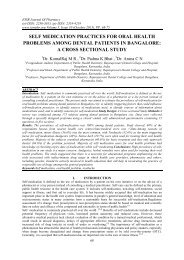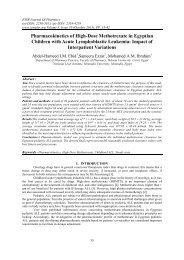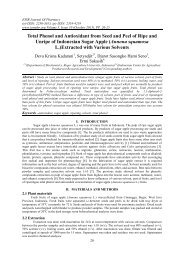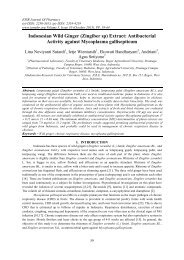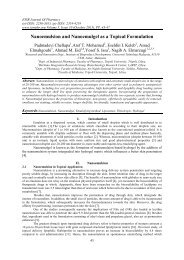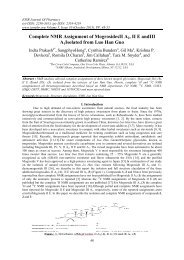IOSR Journal of Pharmacy (IOSRPHR)
The IOSR Journal of Pharmacy (IOSRPHR) is an open access online
The IOSR Journal of Pharmacy (IOSRPHR) is an open access online
You also want an ePaper? Increase the reach of your titles
YUMPU automatically turns print PDFs into web optimized ePapers that Google loves.
<strong>IOSR</strong> <strong>Journal</strong> Of <strong>Pharmacy</strong><br />
(e)-ISSN: 2250-3013, (p)-ISSN: 2319-4219<br />
Www.Iosrphr.Org Volume 3, Issue 7 (August 2013), Pp 63-70<br />
Formulation and Stabilization <strong>of</strong> Duloxetine Hydrochloride Delayed<br />
Release Pellets with the Aid Non Ionic Barrier Layer<br />
Raja Subburayalu 1 ,Dr.Janakiraman Kunchithapatham 1 , Dr.Ramkumar Pillappan 2<br />
1<br />
Department <strong>of</strong> <strong>Pharmacy</strong>, Annamalai University, Annamalai Nagar, Chidambaram, Tamil Nadu, India, 2<br />
Orchid<br />
Chemicals & Pharmaceuticals Ltd., SIPCOT Industrial Park, Irungattukottai, Sriperumbudur 602105, Tamil Nadu,<br />
India,<br />
ABSTRACT: The main objective <strong>of</strong> the present study is to formulate a stable Duloxetine HCl delayed release<br />
pellets with the aid <strong>of</strong> non ionic protective layer between drug layer and enteric layer. Duloxetine HCl is highly<br />
unstable at acidic environment. The preformulation study reveals, Duloxetine HCl is incompatible with enteric<br />
polymers, due to the presence <strong>of</strong> free acid in the enteric polymer. Duloxetine HCl is also unstable at alkaline pH.<br />
Hence, a nonionic polymer is selected in barrier coating. Duloxetine hydrochloride enteric coated pellets were<br />
formulated using fluidized bed process with different levels <strong>of</strong> barrier coating. Three separate layers, the drug layer,<br />
the barrier layer and the enteric layer, were coated on to the inert core pellets, sugar spheres. The enteric coated<br />
pellets were top coated using film coating material and encapsulated in hard gelatin capsule shell. The probability<br />
<strong>of</strong> interaction <strong>of</strong> enteric polymer with duloxetine is very high during shelf life. The filled capsules were evaluated for<br />
description, Assay, Acid resistance and Drug release in pH 6.8 Phosphate buffer at initial and 6 months accelerated<br />
condition (40 ± 2°C/75± 5%RH), to conclude the % build up <strong>of</strong> barrier coating required to avoid the interaction<br />
between duloxetine hydrochloride and enteric polymer. The formulation with 10% & 15% barrier coating are failed<br />
to control the interaction between duloxetine hydrochloride and enteric polymer. The formulation with 20% barrier<br />
coating was found to be stable, and the interaction between duloxetine hydrochloride and enteric polymer was<br />
controlled.<br />
KEYWORDS: Dissolution, Duloxetine Hydrochloride, Enteric coated pellets, Acid resistance.<br />
I. INTRODUCTION<br />
Duloxetine hydrochloride{(+)-(S)-N-methyl-3-(1-naphthyloxy)-3-(thio- phen-2-yl)-propan-1-amine<br />
hydrochloride} } is categorized as an antidepressant, belongs to the class <strong>of</strong> Seratonin and Nor-adrenaline reuptake<br />
inhibitor 3,4. Preclinical studies have shown that Duloxetine HCl is a potent inhibitor <strong>of</strong> neuronal serotonin and<br />
norepinephrine reuptake and a less potent inhibitor <strong>of</strong> dopamine reuptake and so used to treat Major Depressive<br />
Disorders 5 .Duloxetine undergoes many degradation reactions and the most common degradation is by hydrolysis. αnaphthol<br />
duloxetine (4-(3-methylamino-1-thiophen-2-yl-propyl)-naphthalene-1-ol hydrochloride), 4-naphthol<br />
duloxetine (name 4- (3-methylamino-1-thiophen-2-yl-propyl)- naphthalene-1-ol hydrochloride) and 3-Acetyl<br />
duloxetine ((+)-N-methyl-3-(1-naphthalenyloxy)- 3-mine hydrochloride) impurities are the degradants formed by<br />
hydrolysis 1 . Duloxetine is acid liable, acid hydrolysis <strong>of</strong> the ether linkage produces a thienyl-alcohol and 1-napthol.<br />
50% <strong>of</strong> the duloxetine was hydrolysed to napthol in 1 hour at pH 1.2, which is achieved under fasting conditions. At<br />
pH 2.0 there is approximately 10% degradation in 1 hour, and at pH 4.0, 10% degrades in 63 hours. 1-napthol is<br />
extremely toxic and produces cramping, abdominal pain, nausea and vomiting 2. Pellets have gained importance over<br />
the years due to their distinctive advantages in both technological and therapeutic aspects 6 . One <strong>of</strong> the proven<br />
approaches was, formulation <strong>of</strong> delayed release dosage forms (single unit or multiple units) by using different<br />
enteric polymers in a Fluidized bed processor (FBP) by solution/suspension layering. Multiple unit particulate<br />
system show better in vitro release behavior than other dosage forms 7 .So, in the present study, Duloxetine<br />
hydrochloride delayed release capsules containing pellets were prepared by suspension layering technique, using<br />
fluid bed processor and studied.<br />
II. MATERIALS AND METHODS<br />
MATERIALS:<br />
The following chemicals were obtained from commercial suppliers and used as received:<br />
Duloxetine Hydrochloride (Orchid chemicals and pharmaceuticals, Chennai), Sugar spheres 710-850µ (Werner,<br />
USA), HPMC 5cps (Dow chemicals, USA), Opadry white Y-1-7000 (colorcon, India) Hypromellose phthalate<br />
63
64<br />
Formulation And Stabilization Of Duloxetine …<br />
HPMCP HP-50 and HP- 55s (Shin Etsu, Japan), Hypromellose acetate succinate-HPMCAS-MF (Shin-Etsu,japan),<br />
Polymethacrylic acid copolymer Eudragit L100-55 (Evonic Degussa), Cellulose acetate phthalate (Dow chemicals,<br />
USA), Polyvinyl acetate phthalate (Colorcon, USA), Talc (Luzenac, Italy), Triacetin (Speziol-GTA) (Cognis corpn,<br />
USA),Isopropyl alcohol and methylene chloride was procured from RFCL Limited., New Delhi,. All chemicals were<br />
reagent grade or higher.<br />
Digital weighing balance (C-220) (make: Saritorious), Remi mechanical propellant stirrer (RA124)<br />
(make:Remi), Fluid bed processor (GPCG 1.1) (make : pam glatt), Automatic capsule filling machine (AFT-Lab)<br />
(make: Pam machinaries), Tray drier (make : Ganson engg), double beam UV Visible spectrophotometer (make:<br />
schimadzu), Dissolution test apparatus (Electrolab),<br />
Methods:<br />
a. Drug-Enteric polymer compatibility study:<br />
Duloxetine HCl is individually mixed with different enteric polymers, sifted through ASTM 40#, loaded in<br />
to 40±2°C/75±5%RH accelerated stability chamber and exposed for four weeks. Samples are withdrawn after 2<br />
weeks and 4 weeks. The physical admixture <strong>of</strong> the samples exposed are evaluated at Initial, 2 weeks and 4 weeks at<br />
exposed condition for Description & Assay<br />
Table-1: Duloxetine HCl and Enteric polymer Compatibility study:<br />
S.No Drug + Excipient Ratio<br />
1 Duloxetine HCl (D) -<br />
2 D + Hypromellose phthalate HP 55s 1 : 0.5<br />
3 D + Hypromellose phthalate HP 50 1 : 0.5<br />
4 D + Hypromellose acetate succinate (HPMCAS-LF) 1 : 0.5<br />
5 D + Polymethacrylic acid copolymer ( Euragit L100-55) 1 : 0.5<br />
6 D + Cellulose acetate Phthalate 1 : 0.5<br />
7 D + Polyvinyl acetate phthalate 1 : 0.5<br />
b. Preparation <strong>of</strong> Pellets 8,9<br />
Formulation <strong>of</strong> duloxetine delayed release pellets involves 4 stages<br />
a) Stage – I : Drug layering<br />
b) Stage - II : Barrier coating<br />
c) Stage - III : Enteric coating<br />
d) Stage - IV : Top coating<br />
Stage –I Preparation <strong>of</strong> Duloxetine HCl drug layered pellets:<br />
Hypromellose (HPMC E5 LV) was added in purified water under stirring, mixed for 45 minutes to get clear<br />
solution.<br />
Duloxetine Hcl was added to the above solution under stirring, mixed for 30 minutes to get uniform<br />
homogeneous dispersion.<br />
Corn starch and talc were added to the above binder solution, mixed for 30 minutes to get uniform<br />
homogeneous dispersion.<br />
The resulting suspension was filtered through ASTM 60#.<br />
Sugar spheres (710-850µ) <strong>of</strong> 480g was loaded in Fluid bed processor, GPCG 1.1, with bottom spray<br />
assembly, drug layering suspension was coated on sugar spheres. The process parameters are tabulated in<br />
table 3.<br />
The solid content <strong>of</strong> drug layering suspension was 20% w/w.<br />
Each formula was having the batch size <strong>of</strong> 4000 units.<br />
To achieve 100% drug layering, the overage <strong>of</strong> 5% was used in the formulation.<br />
Stage –II Preparation <strong>of</strong> Duloxetine HCl barrier coated pellets:<br />
Barrier coating solution was prepared by dispersing Opadry white Y-1-7000 in purified water, mixed for<br />
45 minutes.<br />
10% w/v solution was prepared<br />
The resulting suspension was filtered using ASTM 60#, and coated on 212g <strong>of</strong> drug layered pellets using<br />
fluid bed processor (GPCG 1.1)
65<br />
Formulation And Stabilization Of Duloxetine …<br />
Barrier coating was performed in different lots, to the weight gain <strong>of</strong> 10% w/w, 15% w/w, 20% w/w, 25%<br />
w/w, 17.5% w/w and 22.5% w/w.<br />
During the preparation <strong>of</strong> coating solution the 10% <strong>of</strong> excess was prepared to recover the loss during<br />
practical work. And the coating solution was sprayed over drug layered pellets using Fluid bed coater until<br />
weight gain was achieved and % yield was calculated.<br />
The solid content <strong>of</strong> barrier coating suspension was 10% w/w<br />
The lot size for barrier coating was 1000 units.<br />
Stage-III: Preparation <strong>of</strong> Duloxetine HCl Enteric coated pellets:<br />
Hypromellose phthalate HP 50 and HP 55s were suspended in isopropyl alcohol under stirring, mixed for<br />
10 minutes to get uniform suspension.<br />
Methylene chloride was added slowly to the slurry and mixed for 45 minutes, to get clear solution.<br />
Triacetin was added to the above solution under stirring, mixed for 10 minutes.<br />
Talc was suspended in purified water separately, added to the above solution and mixed for 30 minutes.<br />
The resulting suspension was filtered through ASTM 60#, coated on barrier coated pellets using fluid bed<br />
processor (GPCG 1.1)<br />
During the preparation <strong>of</strong> coating solution the 10% <strong>of</strong> excess was prepared to recover the loss during<br />
practical work. And the coating solution was sprayed over barrier coated pellets using Fluid bed coater until<br />
weight gain was achieved and % yield was calculated.<br />
The solid content <strong>of</strong> enteric coating suspension was 7% w/w<br />
Stage-IV Preparation <strong>of</strong> Duloxetine HCl Top coated pellets:<br />
Top coating solution was prepared by dispersing Opadry white Y-1-7000 and Talc in purified water, mixed<br />
for 45 minutes.<br />
The resulting suspension was filtered using ASTM 60#, and coated on enteric coated pellets using fluid<br />
bed processor (GPCG 1.1)<br />
Barrier coating was performed in different lots, to the weight gain <strong>of</strong> 5% w/w.<br />
During the preparation <strong>of</strong> coating solution the 10% <strong>of</strong> excess was prepared to recover the loss during<br />
practical work. And the coating solution was sprayed over enteric coated pellets using Fluid bed coater<br />
until weight gain was achieved and % yield was calculated.<br />
The solid content <strong>of</strong> barrier coating suspension was 10% w/w<br />
The lot size for enteric coating was 1000 units.<br />
Encapsulation:<br />
The top coated pellets were cured for 2 hrs using tray drier, at 50°C .<br />
The cured pellets were filled in to size “1” hard gelatin capsules, and evaluated for assay, dissolution and acid<br />
resistance.<br />
Note: Top coated pellets were used for direct exposure study, and filled capsules were loaded on stability as per<br />
ICH requirements.<br />
Table-2 Composition <strong>of</strong> Duloxetine HCl Enteric coated pellets<br />
Duloxetine Drug layering<br />
S.No Ingredients DE-1 DE-2 DE-3 DE-4 DE-5 DE-6<br />
1 Sugar spheres (710-850µ) 120 120 120 120 120 120<br />
2 Duloxetine Hcl 67.3 67.3 67.3 67.3 67.3 67.3<br />
3 Hypromellose (5 cps) 10 10 10 10 10 10<br />
5 Talc USP 5 5 5 5 5 5<br />
6 Corn starch NF 9.7 9.7 9.7 9.7 9.7 9.7<br />
7 Purified water qs qs qs qs qs qs<br />
Sub total 212 212 212 212 212 212<br />
Barrier coating (% w/w)<br />
BE-1 BE-2 BE-3 BE-4 BE-5 BE-6<br />
10% 15% 20% 25% 17.5% 22.5%<br />
1 Opadry white Y-1-7000 21.2 31.8 42.4 53 37.1 47.7<br />
2 Purified water qs qs qs qs qs qs<br />
Sub total 233.2 243.8 254.4 265 249.1 259.7
Enteric coating<br />
66<br />
Formulation And Stabilization Of Duloxetine …<br />
EE-1 EE-2 EE-3 EE-4 EE-5 EE-6<br />
1 Hypromellose Phthalate HP-55 13.60 14.22 14.84 15.46 14.53 15.15<br />
2 Hypromellose Phthalate HP-50 25.26 26.41 27.56 28.71 26.99 28.13<br />
3 Triacetin USP 3.89 4.06 4.24 4.42 4.15 4.33<br />
4 Talc USP 3.89 4.06 4.24 4.42 4.15 4.33<br />
5 Isopropyl alcohol qs qs qs qs qs qs<br />
6 Methylene chloride qs qs qs qs qs qs<br />
7 Purified water qs qs qs qs qs qs<br />
Top coating<br />
Sub total 279.84 292.56 305.28 318.00 298.92 311.64<br />
TE-1 TE-2 TE-3 TE-4 TE-5 TE-6<br />
1 Opadry white Y-I-7000 10.49 10.97 11.45 11.93 11.26 11.64<br />
2 Talc USP 3.50 3.66 3.82 3.98 3.75 3.88<br />
3 Purified water qs qs qs qs qs qs<br />
Sub total 293.83 307.19 320.54 333.90 315.20 325.89<br />
Encapsulation<br />
CE-1 CE-2 CE-3 CE-4 CE-5 TE-6<br />
1 Size „1‟ hard gelatin capsule shell 1 1 1 1 1 1<br />
Table-3 Processing parameters at various steps:<br />
Processing parameters Drug Coating Barrier coating Enteric coating Top coating<br />
Inlet Temperature (°C) 55-58 52-55 40-43 52-55<br />
Exhaust Temperature (°C) 32-36 31-32 27-28 31-32<br />
Product Temperature (°C) 40-44 41-43 32-33 41-43<br />
Spray rate (g/min) 2.5-7 1.8-2 3-5 1.8-2<br />
Atomization (bar) 1.1-1.5 1.1-1.3 1.1-1.3 1.1-1.3<br />
Air flow (CFM) 52-73 52-70 52-68 52-70<br />
Spray nozzle dia (mm) 1.0 0.8 0.8 0.8<br />
Stability study 10<br />
Stability testing <strong>of</strong> drug products begins as a part <strong>of</strong> drug discovery and ends with the emise <strong>of</strong> the<br />
compound or commercial product. FDA and ICH specify the guidelines for stability testing <strong>of</strong> new drug products, as<br />
a technical requirement for the registration <strong>of</strong> pharmaceuticals for human use. The ICH Guidelines have established<br />
different temperatures and period <strong>of</strong> tability testing. The top coated pellets <strong>of</strong> formulation TE-1 to TE-6 were filled<br />
in size‟1‟capsules, packed in HDPE bottle, and loaded on stability chamber as per ICH guidelines, as mentioned in<br />
table-4.<br />
Table-4: ICH guidelines for Stability Study<br />
Study Storage Condition Time<br />
Long term 25°C±2°C / 60% RH±5% RH 12 month<br />
Intermediate 30°C±2°C /65% RH±5% RH 12 months<br />
Accelerated 40°C±2°C /75% RH±5% RH 6 months<br />
To evaluate the impact <strong>of</strong> barrier coating in short period, the product is evaluated at accelerated stability condition.<br />
Evaluation <strong>of</strong> Duloxetine HCl Enteric coated pellets<br />
Assay 11,13 :<br />
Pellets from the capsule were dispersed in to 190 ml <strong>of</strong> pH 6.8 phosphate buffers by ultra -sonication for 30<br />
minutes followed by 10 minutes stirring using magnetic stirrer. The solution was then filtered and the residues over<br />
filter paper were washed with 10 ml phosphate buffer. The solution was then diluted up to suitable concentration and<br />
absorbance was measured using double beam UV-VIS Spectrophotometer at 289 nm.
Formulation And Stabilization Of Duloxetine …<br />
Acid Resistance test 11<br />
Principle: Residual Assay<br />
Apparatus: USP Dissolution apparatus type I (basket)<br />
Simulated Gastric fluid: 0.1N HCl (pH 1.2)<br />
Volume <strong>of</strong> media: 1000 ml<br />
Capsules were placed in the Basket and were rotated at 100 rpm at 37 ± 0.5oC for 2 (Two) hours. After two<br />
hours drug content left in the pellets was assayed. Pellets left in the Basket after two hours were dissolved in 190ml<br />
6.8 pH Phosphate buffer for 30 minute by Ultra sonicator followed by 10 min stirring using magnetic stirrer until<br />
pellets disintegrates completely. The solution was filtered and the residues over filter paper were washed with 10 ml<br />
phosphate buffer. The solution was then diluted up to suitable concentration and absorbance was measured using<br />
double beam UV-VIS Spectro photometer at 289nm. Drug release in 0.1 N HCl was calculated using following<br />
equation.<br />
Drug released in Gastric Fluid = Drug content <strong>of</strong> Capsule – Residual Assay…... (I)<br />
In-vitro drug release study 12<br />
Capsules were evaluated for in-vitro release study in 0.1 N HCl and phosphate buffer 6.8 pH.<br />
The drug dissolution test <strong>of</strong> Capsule was carried out using USP Dissolution apparatus type I (basket). Capsules were<br />
placed into the baskets and 1000 ml <strong>of</strong> 0.1 N HCl (pH 1.2) solution was filled in to the beaker. The baskets were<br />
rotated at 100 rpm. Buffer temperature was maintained<br />
at 37 ± 0.5 ºC for two hours. Then 0.1 N HCl solution was replaced with 1000 ml <strong>of</strong> pH 6.8 phosphate buffer and the<br />
baskets were rotated at 100 rpm and 37 ± 0.5 ºC buffer temperature. Then 10 ml <strong>of</strong> sample aliquots were collected at<br />
90 minutes. The absorbance <strong>of</strong> sample was then measured using Double beam UV Visible spectrophotometer at 289<br />
nm.<br />
Results & Discussions:<br />
Drug-Enteric polymer compatibility study:<br />
The drug –enteric polymer compatibility study is conducted for assay and description, the results are<br />
tabulated in Table 5.<br />
Duloxetine HCl -<br />
D + Hypromellose<br />
phthalate HP 55s<br />
D + Hypromellose<br />
phthalate HP 50<br />
D + Hypromellose acetate<br />
succinate<br />
D + Polymethacrylic acid (<br />
Euragit L100-55)<br />
D + Cellulose acetate<br />
Phthalate<br />
D + Polyvinyl acetate<br />
phthalate<br />
Drug +<br />
Excipient<br />
(ratio)<br />
1 + 0.5<br />
1 + 0.5<br />
1 + 0.5<br />
1 + 0.5<br />
1 + 0.5<br />
1 + 0.5<br />
Initial<br />
2 Week<br />
40 ±2°C/75±5%RH<br />
4 Week 40/75<br />
40 ±2°C/75±5%RH<br />
Description Assay Description Assay Description<br />
White to <strong>of</strong>f<br />
white powder<br />
Off - white<br />
powder<br />
Off - white<br />
powder<br />
Off - white<br />
powder<br />
Off - white<br />
powder<br />
Off - white<br />
powder<br />
Off - white<br />
powder<br />
The results <strong>of</strong> compatibility study reveal that the drug is not compatible enteric polymer. Around 10%<br />
drop in potency is observed after 4 week direct exposure. Hence, a strong protective layer is required to prevent the<br />
interaction between duloxetine HCl and enteric coating material.<br />
Physical Description <strong>of</strong> pellets filled in capsules:<br />
Table 6: Comparison <strong>of</strong> physical description <strong>of</strong> Duloxetine Hcl delayed release capsules 60mg (Initial Vs<br />
6 months 40 ± 2°C/75 ± 5% RH )<br />
67<br />
99.6<br />
101.1<br />
99.9<br />
101.1<br />
99.6<br />
100.2<br />
99.6<br />
<strong>of</strong>f white<br />
powder<br />
pale pink colored<br />
powder<br />
pale pink colored<br />
powder<br />
pale pink colored<br />
powder<br />
pale pink colored<br />
powder<br />
pale pink colored<br />
powder<br />
pale pink colored<br />
powder<br />
99.3<br />
95.8<br />
96.5<br />
96.5<br />
98.5<br />
96.5<br />
94.3<br />
Off white to<br />
pale pink<br />
powder<br />
pink colored<br />
mass<br />
pink colored<br />
mass<br />
pink colored<br />
mass<br />
pale pink<br />
colored powder<br />
pale pink<br />
colored powder<br />
pink colored<br />
mass<br />
Assa<br />
y<br />
98.6<br />
89.2<br />
89.3<br />
88.3<br />
95.6<br />
83.5<br />
84.9
68<br />
Formulation And Stabilization Of Duloxetine …<br />
Batch Number↓ Physical Description<br />
Initial 6 months 40 ± 2°C/75 ± 5% RH<br />
CE1<br />
White to <strong>of</strong>f white colored pellets filled in pink colored pellets filled in size "1" hard<br />
(10% barrier coated) size"1" hard gelatin capsules<br />
gelatin capsules<br />
CE2<br />
White to <strong>of</strong>f white colored pellets filled in Off white –to pale pink colored pellets filled in<br />
(15% barrier coated) size"1" hard gelatin capsules<br />
size"1" hard gelatin capsules<br />
CE3<br />
(20% barrier coated)<br />
CE4<br />
(25% barrier coated)<br />
CE5<br />
(17.5% barrier coated)<br />
CE6<br />
(22.5% barrier coated)<br />
White to <strong>of</strong>f white colored pellets filled in<br />
size"1" hard gelatin capsules<br />
White to <strong>of</strong>f white colored pellets filled in<br />
size"1" hard gelatin capsules<br />
White to <strong>of</strong>f white colored pellets filled in<br />
size"1" hard gelatin capsules<br />
White to <strong>of</strong>f white colored pellets filled in<br />
size"1" hard gelatin capsules<br />
White to <strong>of</strong>f white colored pellets filled in<br />
size"1" hard gelatin capsules<br />
White to <strong>of</strong>f white colored pellets filled in<br />
size"1" hard gelatin capsules<br />
Off white colored pellets filled in size"1" hard<br />
gelatin capsules<br />
White to <strong>of</strong>f white colored pellets filled in<br />
size"1" hard gelatin capsules<br />
Results indicated that Batches CE3, CE4 & CE6 were not having any change in physical description in 6<br />
months accelerated condition. CE1 & CE2 were failed in physical description at 6 months accelerated condition.<br />
From the results it was concluded that minimum 20%w/w barrier coating is required to have stable formulation.<br />
Drug content:<br />
Initial and Accelerated stability samples <strong>of</strong> the filled capsules were evaluated for Drug content & acid<br />
resistance. The results are tabulated in Table:<br />
Batch<br />
Numb<br />
er↓<br />
Table 7: Drug content & Acid resistance: (Initial Vs Stability)<br />
Drug content* Acid resistance*<br />
Initial 6 months<br />
Accelerated<br />
Initial 6 months Accelerated<br />
Residual Assay % Drug<br />
Release in<br />
0.1N HCl*<br />
Residual Assay % Drug<br />
Release in<br />
0.1N HCl*<br />
CE1 100.1 ± 0.26 63.5 ± 0.12 99.5 ± 0.12 0.6 37.9± 4.56 25.6<br />
CE2 99.8 ± 0.44 96.5 ± 0.06 99.3 ± 0.17 0.5 89 ± 2.86 7.5<br />
CE3 99.7 ± 0.40 98.4 ± 0.45 99.4 ± 0.42 0.3 96.4 ±0.62 2.0<br />
CE4 100.3 ±0.56 99.5 ± 0.06 99.5 ± 0.06 0.8 97.6 ± 0.96 1.9<br />
CE5 100.5 ±0.44 98.6 ± 0.06 99.8 ± 0.76 0.7 97.3 ± 0.91 3.3<br />
CE6 100.2 ±0.40 99.5 ± 0.06 99.6 ± 0.3 0.6 97.7 ± 0.71 1.9<br />
*Listed value indicates mean value <strong>of</strong> results and Standard deviation (Where n=3)<br />
Graph-1: Comparative % drug release <strong>of</strong> Duloxetine HCl Initial Vs 6M 40/75 - in 0.1N HCl for 2 hrs<br />
The drug content and acid resistance results indicated that Batch CE1 is having high degradation after 6<br />
months accelerated condition. 10% barrier coating is not sufficient to make a barrier between drug layer and enteric<br />
layer. Formulation CE2 was not failing for drug content, but there was 10% drop in acid resistance. Hence, 15%<br />
barrier coating is also not making a strong barrier between drug layer and enteric layer. The batches CE3 to CE6<br />
produced good acid resistance. From the results it was concluded that minimum 20%w/w barrier coating is required<br />
to have stable formulation.
69<br />
Formulation And Stabilization Of Duloxetine …<br />
In-Vitro Drug release study<br />
In-vitro drug release study was performed using USP apparatus-I (Basket type) in 0.1 N HCl for<br />
first two hrs followed by pH 6.8 phosphate buffer for 90 mins.<br />
Table 8:<br />
Batch No.↓ % Drug Release in 0.1N HCl for first 2 hours then in pH 6.8<br />
phosphate buffer for 90 mins*<br />
Initial 6 months Accelerated<br />
CE1 95 ± 1.00 47 ± 5.69<br />
CE2 92 ± 1.73 75 ± 3.79<br />
CE3 96 ± 2.00 94 ± 1.53<br />
CE4 95 ± 2.00 91 ± 1.53<br />
CE5 95 ± 1.00 90 ± 2.65<br />
CE6 93 ± 2.31 89 ± 4.16<br />
*Listed value indicates mean value <strong>of</strong> results and Standard deviation (Where n=3)<br />
Graph-2: Comparative Dissolution <strong>of</strong> Duloxetine HCl Initial Vs 6M 40/75 - in 0.1N HCl for 2 hrs followed by<br />
pH 6.8 phosphate buffer for 90 minutes.<br />
Results indicated that Batches CE1 & CE2 were failed in dissolution at 6 months accelerated condition.<br />
CE3 to CE6 were meeting the specification. From the results it was concluded that minimum 20%w/w barrier<br />
coating is required to have stable formulation.<br />
III. CONCLUSION<br />
It is observed from the results that duloxetine hydrochloride is highly acid labile drug. All enteric polymers<br />
are incompatible with duloxetine hydrochloride due to the presence <strong>of</strong> free acids in enteric polymer. Duloxetine<br />
also undergoes degradation at pH above 8. Hence, a non ionic protective layer between Duloxetine hydrochloride<br />
and enteric polymer was evaluated with different percentage coating, to stabilize the formulation during shelf life. A<br />
protective layer coating <strong>of</strong> 10% and 15% build up (barrier coat), failed in description, acid resistance and drug<br />
content at accelerated stability condition. The barrier polymer is another factor affecting drug release patterns since<br />
it is the next layer that obstructs the drug release. Therefore, an increase in the concentration <strong>of</strong> the barrier polymer<br />
increases the extent <strong>of</strong> obstruction <strong>of</strong> drug release. The results reveals that the formulation with 20% barrier coating<br />
is stable in accelerated stability testing. The operating range <strong>of</strong> 18% to 22% <strong>of</strong> barrier coating did not affect the<br />
drug release. Processing with Opadry white Y-1-7000 was easier when compared with other hypromellose based<br />
coating material, due to the high talc content and plasticizer.
70<br />
Formulation And Stabilization Of Duloxetine …<br />
REFERENCES:<br />
[1] Vyas, Nagesh, Nagaraju, Pharmaceutical formulations comprising duloxetine, USPTO Patent Application 20090226517(2009).<br />
[2] USFDA, http://www.acessdata.fda.gov, Centre for drug evaluation and research, Application number-21-427,Clinical pharmacology and<br />
Biopharmaceutics review, part-II, page 3 <strong>of</strong> 221<br />
[3] Rang H and Dale M in Pharmacology, Fifth Edn, Elsevier publication, London. 2003, 537.<br />
[4] Fava M and Cassano P in Massachusette General Hospital Comprehensive Clinical Psychiatry 1st edn. Elsevier publications company,<br />
Philadelphia, 2008, 29.<br />
[5] Domenico D, Nicola S and Alessandro C, “The role <strong>of</strong> duloxetine in the treatment <strong>of</strong> anxiety disorders”, Neuropsychiatric Disease and<br />
Treatment 2008, 4, 929–935.<br />
[6] Evdokia S. Korakianiti, Dimitrios M. Rekkas, Paraskevas P. Dallas. Optimization <strong>of</strong> the pelletization process in a Fluid- Bed Rotor<br />
Granulator using experimental design. AAPS PharmSciTech, 1(4):71-5.doi:10.1208/pt010435,(2000).<br />
[7] Kevin A.Wells, BS: and William G. Losin. In Vitro Stability, Potency and Dissolution <strong>of</strong> Duloxetine Enteric- Coated Pellets After Exposure<br />
to Applesauce, Apple Juice and Chocolate Pudding. Clinical Therapeutics,30:1300-8,(2008).<br />
[8] Shravani D, Lakshmi P and Balasubramaniam J, “Preparation and optimization <strong>of</strong> various parameters <strong>of</strong> enteric coated pellets using the<br />
Taguchi L9 orthogonal array design and their characterization”, Acta Pharmaceutica Sinica B, 2011, 1, 56–63.<br />
[9] Istiakh A, Mohammed R and Rahman H, “Delayed release pharmaceutical pellets having Duloxetine HCl containing core and acid resistant<br />
acrylic polymer based outer layer coat”, Bangladesh Pharmaceutical <strong>Journal</strong>, 2010, 13, 9-13.<br />
[10] ICH, GUIDELINES Q1C, “Guidance for industry, stability testing <strong>of</strong> new dosage form” November 1996.<br />
http://www.ich.org/about/organisation-<strong>of</strong>ich/coopgroup/asean/topics-underharmonisation/article/stability-study.html<br />
[11] Vijay R, “A validated UV Spectrophotometric determination <strong>of</strong> an antidepressant drug Duloxetine hydrochloride from capsule<br />
formulations” Int. J. <strong>of</strong> Pharm. and Biosci., 2011, 2, 716-720<br />
[12] 12.. US FDA, “Dissolution method for Duloxetine HCl”, March 2006. http://www.acessdata.<br />
fda.gov/scripts/cder/dissolution/dsp_SearchResults.Dissolution.cfm<br />
[13] Kamila M, Mondal N and Ghosh L, “A validated UV spectrophotometric method for determination <strong>of</strong> duloxetine hydrochloride”,<br />
Pharmazie, 2007, 62, page: 414-415.<br />
[14] Gohel DK*1, Jain AJ1, Patel KN1, Patel BA1, Patel PA, Formulation and Evaluation <strong>of</strong> Delayed Release Pellets <strong>of</strong> Duloxetine HCl<br />
International <strong>Journal</strong> for pharmaceutical Research Scholars (IJPRS) ISSN No: 2277-7873 V-1, I-2, 2012, page 421-436


